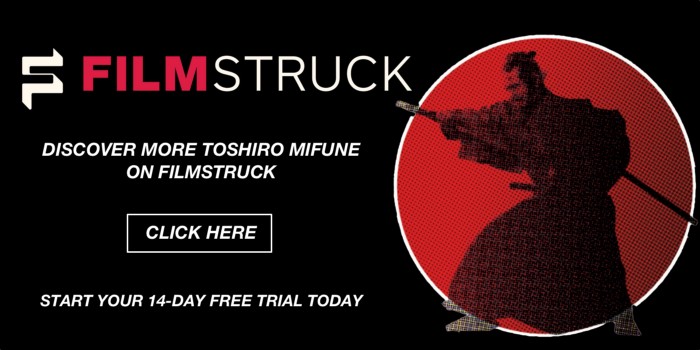Samurai Supreme.

Film SAT analogy question number 1: John Wayne is to cowboy as Toshiro Mifune is to ___________. No multiple choice provided. No multiple choice should be necessary.
The film industry is littered with a near infinite list of great actors in its history. Of those, the list of actors that have left an indelible impression through performance itself exceeds the thousands – if not tens of thousands. Great actors abound throughout history.
What is not in abundance, by sheer definition, are those that reign supreme over an entire category of film. Kings and queens, lords and ladies, Gods and Goddesses. There is only ever one actively designated God over a realm in film’s Mount Olympus – and in the realm of the samurai picture, that God is Toshiro Mifune, “God of the samurai role.”
You can’t speak of an appreciation for Mifune without an acknowledgment that the man sits atop an entire genre. You can’t even begin to speak of the genre without first acknowledging Mifune. He towered over it for nearly two whole decades, and his closest contemporary spent that first decade commonly being Mifune’s onscreen villain – destined to fall at the sword of the king of samurai cinema.
Film SAT analogy question number 2 – Toshiro Mifune is to early 90’s NFC East as Tatsuya Nakadai is to the Buffalo Bills.
I’m just giving you that answer because it’s a film website.
To discuss the accolades due to Mifune for the samurai genre alone would take the time of a motion picture unto itself. His work in motion pictures and television spanned over forty years, and he probably averaged about one samurai role per year of activity – but it was the indelible impression he made throughout the world in these pictures below that keep him up above the group as the most recognizable embodiment of the motion picture samurai.
Rashomon (1950)
Where it all began. The film that put both Mifune and his longtime screen captain, Akira Kurosawa, on the world map as talents to behold for the decades to come.
When put under the microscope along with the other pictures to follow, Rashomon is the one most likely to be exposed for its roughness. Its common consideration as Kurosawa’s first masterpiece (ignoring the release of Stray Dog the year prior) has as much, of not more, to do with the pioneering script and story structure by screenwriter Shinobu Hashimoto (a name as important to the samurai script as Mifune to the samurai lead) than the contributions of its filmmaker and co-starring role of Mifune as the manic bandit at the core of the story’s central theme of truth and trustworthiness of first-hand witnessing.
However, you simply can’t discuss Mifune’s career in samurai roles without recognizing where it began – and it began with one of the most important films in cinema history.
If your introduction to the works of Mifune tends to be relegated to his work in the latter half of the 1950’s and forward, then you’re unlikely to choose the word ‘wild’ as a characteristic to define him as a screen presence. The trajectory of Mifune’s career in samurai roles closely resembles the trajectory of most pre-adolescent males into maturity – and Rashomon is Mifune at his pre-pubescent stage of doctors trying to find out whether or not this child has A.D.D., or traits of genius. For the next few years, it’ll appear he has both.
Seven Samurai (1954)
Graduation-age Mifune. Still wild in action, but convincingly in control and aware. The part of Kikuchiyo is layered – much more so than most of the other samurai in the group. He’s mysterious and angry, and unapologetically brash. But he’s sincere, and more committed to the cause than anyone else in the group – for reasons that stem from his initial mystery.
Most of the films on this list require little introduction or discussion – most of all this one. If you haven’t seen Seven Samurai you’ve still seen Seven Samurai – and it’s all because of the existence of epic filmmaking perfection that is Seven Samurai. It’s been remade no less than 3 times cinematically, spawned its own anime series, and can probably be credited elsewhere. It’s quite possibly the most engrossing four hours of film, if for no other reason than because it feels like two hours.
Samurai Trilogy (1954–1956)
Samurai Mifune from caterpillar to butterfly. The trek from outlaw to legend of real-life warrior Musashi Miyamoto is the perfect bridge between early 50’s Mifune to the career to follow. The maturation of character from one film to the next in the series embodies the roles, for the most part, of Mifune’s samurai characters chronologically in his filmography. The full range of Mifune’s samurai roles can almost be compacted and identified in just these three pictures. Initially unhinged, unwavering, but slowly broken down to the core and built back up to be the mindful warrior of no equal.
This trilogy is best experienced as a whole – seamlessly going from one story to the next. It appears to have been written to have been that way all along, and while it’s certainly episodic in that regard the story as a whole is presented very much in a three-act structure of introduction, body, and climax – and the action mimics that to a T. The introductory picture is the early life, the second film culminates in a one-man versus a whole planet of samurai, and the third film the conflicting duel against the samurai looking to unseat him. Like the best binge-watch worthy shows of our current addictions, you’ll want to watch the next almost immediately.
Throne of Blood (1957)
Yes – Mifune can even do Shakespeare in full on samurai-mode. And, yes, even Mifune can too be lured by the ambitions of very crazy women. Adapted from Shakespeare’s Macbeth, Mifune stars as a general in feudal Japan who, as prophecy would have it, becomes the great lord of a land that is destined to be his demise.
In comparison to the other films on this list, this one is arguably least emblematic of the samurai picture. In fact, it might not necessarily qualify dependent upon where you draw the line. It takes place in the feudal era of Japan, and it certainly has samurai – but its focus isn’t on action so much as turmoil. Where one could argue the inclusion of Rashomon as an important piece of cinema history also despite much samurai activity in comparison to its more important themes, I would argue the inclusion of Throne of Blood similarly rests in importance of letting one be aware of the fact that Toshiro Mifune, even when seldom swinging a sword when equipped with one, is a force of compressed rage and outburst unequaled by his contemporaries.
Just look at the final scene – but don’t deny yourself the pleasure and watch the film first.
The Hidden Fortress (1958)
In a mountain range far, far away. This is Han Solo, Obi Wan Kenobi, Luke Skywalker Toshiro Mifune. While regarded as an influence to George Lucas’ Star Wars – a direct remake Star Wars is not.
Where Throne of Blood represents Mifune at his villainous worst as a general, The Hidden Fortress is him at his heroic best. Trying desperately to get his princess and he safely to allied territory across enemy terrain you will get a strong sense of the chess playing tactician that is the Mifune to come.
Yojimbo and Sanjuro (1961 and 1962)
Samurai Bobby Fischer Mifune. If Seven Samurai is the film that needed the least introduction or discussion due to familiarity then Yojimbo is a very close second. Having been the inspiration for the origin picture of the Eastwood/Leone Man With No Name trilogy, Yojimbo tells how a single samurai uses his wits to be the source of destruction of two criminal organizations – simply by playing for both sides, and pitting each against each side.
These two films are the punctuation of any argument regarding Mifune’s place at the head of the table of samurai action stars. These are the films that you imagine yourself in when you dream about being a samurai – and it’s in this role specifically. Zatoichi is cool – really cool, in fact, and his time in the film industry begins right about here as well. But, it starts with Sanjuro Kuwabatake in 1961. The finale of Yojimbo might be the height of singular Mifune swordplay proficiency, while the finale of Sanjuro contains the most heart-poundingly quiet, 60-second stillness in cinema.
Each film is also the first and second time that Mifune would face the actor with the most ammunition in being considered the greatest of samurai actors.
Samurai Rebellion (1967)
The other great masterpiece featuring both Mifune and Nakadai as leads – and the most heartbreaking in regards to their characters.
Aside from the Samurai Trilogy from filmmaker Hiroshi Inagaki this is the only other non-Kurosawa picture on the list. Not because it’s the only one worth mentioning, but because if there were a filmmaker worthy of consideration at the table of Kurosawa in regards to samurai pictures like Nakadai of Mifune, then it’s Masaki Kobayashi – and that’s based on just two very powerful pictures, this one being one of them.
Like many of the other pictures on this list, its roots stem from the words of Shinobu Hashimoto, whose storylines in film are difficult to find a peer. In this one he’s given Mifune one of his most well-rounded characters in a singular picture. Mifune plays a father in a loveless marriage he’s stuck in for title, and doesn’t want his son to make the make the same mistake when essentially forced to do so by command of the Lord. In this, Mifune plays the calm objector up until the time it’s no longer called for to be calm – and he stands by his son in defense of justice as their affection for his now wife changes in contrast to the changing attitudes of the Lord as well.
Every great list should end with a great picture with a great ending. Samurai Rebellion sees Mifune take on an army, to then take on his samurai contemporary and friend, to then end on taking on army armed the future of weaponry. He goes out like all warriors want to – in a losing battle in the blaze of glory defending your principles with less than what you deserve.

Related Topics: History, Star Wars
